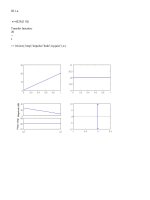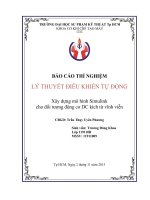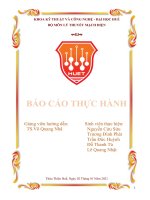báo cáo thí nghiệm lý thuyết mạch điện i
Bạn đang xem bản rút gọn của tài liệu. Xem và tải ngay bản đầy đủ của tài liệu tại đây (746.31 KB, 16 trang )
<span class="text_page_counter">Trang 1</span><div class="page_container" data-page="1">
ĐẠI HỌC BÁCH KHOA HÀ NỘI TRƯỜNG ĐIỆN - ĐIỆN TỬ
BÁO CÁO THÍ NGHIỆM
Lý thuyết mạch điện I
Họ và tên: Nguy n H u Tài ễữMSSV: 20220009
Mã l p: 736259ớHọc kì: 2023.1
</div><span class="text_page_counter">Trang 2</span><div class="page_container" data-page="2">Bài 1
1 Mạch1 - H1 (Trang 1)1, Phương pháp dòng vòng
Các ma trận:
Ma trận nhánh vòng: C=1 00 1
</div><span class="text_page_counter">Trang 3</span><div class="page_container" data-page="3">Thực hiện chương trình trên Matlab
Z1=11+41j; Z2=21+51j; Z3=31+61j;
Z21=0; Z12=Z21;Z32=0.5*sqrt(3111)*j; Z23=Z32; Z31=0.75*sqrt(2501)*j; Z13=Z31;E1=100; E2=200*exp(j*pi/6); J3=10*exp(j*pi/3);
C=[1 0; 0 1; 1 1];
Z=[Z1 Z12 -Z13; Z21 Z2 -Z23; -Z31 -Z32 Z3];En=[E1; E2; 0]; Jn=[0; 0; J3];
linsolve(C’*Z*C, C’*En-C’*Z*Jn)
Và kết quả nhận được: Most readerscan ignore this section. It presents an an-notated version of boxedminipage’s sourcecode. Section 3.1 describes the contents ofboxedminipage.sty. Section 3.2 representsa separate stub file, boxedminipage2e.sty,which merely issues a warning message and
Tìm dịng qua từng nhánh:
Kết quả: Most readers can ignore thissection. It presents an annotated versionof boxedminipage’s source code. Section3.1 describes the contents of boxedmini-page.sty. Section 3.2 represents a sepa-rate stub file, boxedminipage2e.sty, whichmerely issues a warning message and in-structs the author to load boxedminipageinstead of boxedminipage2e.
2.Phương pháp thế nút
Ma trận nhánh nút (Chọn nút B làm đất): A=111
Vector điện thế nút: V<small>d</small>=<sub>ϕ</sub><sub>A</sub> <sup>.</sup> <sub>Vector nguồn dòng nút: J</sub><sub>d</sub><sub>=</sub><sub>J</sub><sub>3</sub><sup>h</sup><sup>i</sup><sup>.</sup>Hệ phương trình thế nút dạng ma trận: A<small>T</small>z<small>−1</small>AV<sub>d</sub>=A<small>T</small>Z<small>−1</small>E<small>n</small>+ J<sub>d</sub>
</div><span class="text_page_counter">Trang 4</span><div class="page_container" data-page="4">Thực hiện chương trình trên Matlab
A=[1; 1; -1];Jd=[J3];
Kết quả: Most readers can ignore thissection. It presents an annotated versionof boxedminipage’s source code. Section3.1 describes the contents of boxedmini-page.sty. Section 3.2 represents a separate
stub file, boxedminipage2e.sty, which merely issues a warning message and instructsauthor to load boxedminipage instead of boxedminipage2e.
Tìm dịng điện qua các nhánh:inv(Z)*((-1)*A*ans+En)
Kết quả: Most readers can ignore thissection. It presents an annotated versionof boxedminipage’s source code. Section3.1 describes the contents of boxedmini-page.sty. Section 3.2 represents a sepa-rate stub file, boxedminipage2e.sty, whichmerely issues a warning message and in-structs the author to load boxedminipageinstead of boxedminipage2e.
</div><span class="text_page_counter">Trang 5</span><div class="page_container" data-page="5">Ma trận nhánh vòng: C=1 0 00 1 01 1 01 0 10 1 10 0 1
Ma trận tổng trở nhánh: Z=
Z<small>1</small> 0 0 0 0 00 Z<small>2</small> 0 0 0 00 0 Z<small>3</small> 0 −Z<small>35</small> 00 0 0 Z<small>4</small> 0 00 0 −Z<small>53</small> 0 Z<small>5</small> 00 0 0 0 0 Z<small>6</small>
Vector dòng vòng: I<small>v</small>=<sup>I</sup><sup>h</sup><sup>v1</sup><sup>.</sup>
i<sub>T</sub>
</div><span class="text_page_counter">Trang 6</span><div class="page_container" data-page="6">Vector suất điện động nhánh: E<sub>n</sub>=<sup>E</sup><sup>h</sup><sup>1</sup><sup>.</sup>
E<small>2</small> 0 0 0 0 0<sup>i</sup><sup>T</sup>Vector nguồn dòng nhánh: J<small>n</small>=<sup>h</sup>0 0 0 0 0
Z=[Z1 0 0 0 0 0; 0 Z2 0 0 0 0; 0 0 Z3 0 -Z35 0; 0 0 0 Z4 0 0; 0 0 -Z35Z6];
En=[E1; E2; 0; 0; 0; 0]; Jn=[0; 0; 0; 0; 0; -J6];linsolve(C’*Z*C, C’*En-C’*Z*Jn)
Kết quả: Earlier this year, for the firsttime, a paper was published on the impactof heat stress in large Arctic seabirds. Nor-mally, research on species in that cornerof the world is about adaptations to thecold, but in an era of climate chaos, learn-ing to live with heat is the new challenge.As well as undergoing physical changes, an-imals across the world are changing theirbehaviour – murres, for example, are spend-ing more time getting into the water to cooloff, leaving their eggs exposed to gulls andArctic foxes. For parents, it’s a trade-off be
</div><span class="text_page_counter">Trang 7</span><div class="page_container" data-page="7">b) Điện áp trên mỗi nhánh:
Kết quả: Earlier this year, for the firsttime, a paper was published on the impactof heat stress in large Arctic seabirds. Nor-mally, research on species in that cornerof the world is about adaptations to thecold, but in an era of climate chaos, learn-ing to live with heat is the new challenge.As well as undergoing physical changes, an-imals across the world are changing theirbehaviour – murres, for example, are spend-ing more time getting into the water to cooloff, leaving their eggs exposed to gulls andArctic foxes. For parents, it’s a trade-off be-tween keeping cool enough to avoid heatstress and protecting their young. Manybirds with similar ecological niches
c) Tổng công suất các nguồn
P=-real(E<sup>.</sup><small>1</small>conj(I<sup>.</sup><small>1</small>)) - real(E<sup>.</sup><small>2</small>conj(I<sup>.</sup><small>2</small>)) + real(U<sup>.</sup><small>6</small>conj(J<sup>.</sup><small>6</small>)) = -966.8709 (W)
</div><span class="text_page_counter">Trang 8</span><div class="page_container" data-page="8">i<small>1</small>=<sup>−10</sup><sub>11</sub> <sup>(A)</sup> <sup>i</sup><small>2</small>=<sup>10</sup>
11<sup>(A)</sup> <sup>i</sup><sup>3</sup><sup>=</sup>−20
11 <sup>(A)</sup> <sup>i</sup><sup>4</sup><sup>= 0(A)</sup> <sup>i</sup><sup>5</sup><sup>=</sup>20
11<sup>(A)</sup>
</div><span class="text_page_counter">Trang 9</span><div class="page_container" data-page="9">Z<small>L</small>= 100j(Ω) Z<small>C</small>= −100 (Ω)j
E<small>1</small>= 200e<small>(</small>j ∗ 0) = 200 0(V )R1=200; R2=R1; R3=10; Zl=100j; Zc=-Zl;
C=[1 0 0; 1 1 0; 0 1 0; 0 1 1; 0 0 1];
Z=[R1 0 0 0 0; 0 R2 0 0 0; 0 0 R3 0 0; 0 0 0 Zc 0; 0 0 0 0 Zl];En=[E1; 0; 0; 0; 0];
Jn=[0; 0; 0; 0; 0];
linsolve(C’*Z*C, C’*En-C’*Z*Jn)
Kết quả nhận được:I<sup>.</sup><small>3</small>= 0(A)
Vậy khi mạch bao gồm cả hai nguồn áp, dòng điện nhánh i<sub>11</sub>(A).<small>3</small>=<sup>40</sup>
c) Khi mạch bao gồm cả hai nguồn áp, dòng qua nhánh i<small>1</small>= 0.5<sup>√</sup>2 sin (ωt) −<sub>11</sub><sup>(A)</sup> <sup>10</sup>⇒Công suất tác dụng của nguồn e<small>1</small>:
syms x
Pe1=-(1/0.02)*int(sqrt(2)*200*sin(100*pi*x)*(0.5*sqrt(2)*sin(100*pi*x)-Kết quả nhận được: P<small>e1</small>= −100(W ).
</div><span class="text_page_counter">Trang 10</span><div class="page_container" data-page="10">Nhận xét: Kết quả phần chuẩn bị ở nhà trùng khvới kết quả tính được trong khi thí nghiệm.
</div><span class="text_page_counter">Trang 11</span><div class="page_container" data-page="11">→I<small>R</small> −→<sub>U</sub><sub>R</sub>
U<small>R</small>= 24.87(V)I<sub>R</sub>= 0.164(A)P<small>R</small>= 4.076(W)cos(ϕ)= 1
2) Mạch thuần điện cảm (L = L<small>1</small>có trên bảng mạch)
U<small>L</small>= 24.85(V)I<small>L</small>= 0.525(A)P<sub>L</sub>= 2.870(W)cos(ϕ)= 0.220
3) Mạch thuần điện dung (C = C<small>1</small>có trên bảng mạch)
</div><span class="text_page_counter">Trang 12</span><div class="page_container" data-page="12">U<small>C</small>= 25.02(V)I<sub>C</sub> = 0.171(A)P<small>C</small>= 0.034(W)cos(ϕ)= 0.007
4) Mạch R-L nối tiếp (R = R<small>9</small>,L = L<small>1</small>+ L<small>2</small>có trên bảng mạch)
I = 0.149(A)U<small>L</small>= 6.620(V)P = 3.558(W)
5) Mạch R-C nối tiếp (R = R<sub>9</sub>,C = C<small>3</small>+C<small>2</small>có trên bảng mạch)
</div><span class="text_page_counter">Trang 13</span><div class="page_container" data-page="13">U = 25.89(V)U<small>R</small>= 11.064(V)S= 1.817(W)cos(ϕ)= 0.455
I = 0.073(A)U<small>C</small>= 22.23(V)P = 0.829(W)
6) Mạch R-L-C nối tiếp (R = R<sub>9</sub>,L= L<small>1</small>+L<small>2</small>+L<small>3</small>,C = C<small>1</small>+C<small>2</small>+C<small>3</small>có trên bảngmạch)
U = 24.88(V)I = 0.068(A)U<small>R</small>= 10.218(A)cos(ϕ)= 0.568
U<sub>L</sub>= 27.48(V)U<small>C</small>= 6.778(V)S = 1.691(W)P = 0.955(W)
</div><span class="text_page_counter">Trang 14</span><div class="page_container" data-page="14">Nhận xét:
Quan hệ dịng, áp, cơng suất đã được nghiệm đúng trên mỗi phép đo: P = UIcos(ϕ
Từ số liệu đo tính được: R<small>9</small>≈ 151(Ω)
Đối với cuộn dây L<small>1</small>: L<small>1</small>≈ 0.147(H),r<small>1</small>≈46 17(Ω).C1 ≈ 21. .75 10<small>−6</small>(F )
Quan hệ điện áp trên mạch điện:U =<sup>→</sup><sup>−</sup><sup>−→</sup>U<small>R</small>+<sup>−</sup><sup>→</sup>U<small>L</small>+<sup>−→</sup><sup>U</sup><small>C</small>
</div><span class="text_page_counter">Trang 15</span><div class="page_container" data-page="15">Bài 3
Thí nghiệm tại bàn số 1: Đặt nguồn điện áp hình sin với giá trị hiệu dụng U = 1
1) Nghiệm chứng lại định luật Kirchhoff 1 (<sup>P</sup>i = 0)Nguồn có giá trị hiệu dụng 24V
I<small>1</small> R<small>1</small> I<small>2</small> I<small>3</small>
U = 24.88(V)I<small>1</small>= 0.272(A)cos(ϕ<small>1</small>)= 0.633I<small>2</small>= 0.107(A)cos(ϕ<small>2</small>)= 0.07I<small>3</small>= 0.195(A)cos(ϕ<small>3</small>)= 0.846
Nghiệm chứng lạ định luật Kichhoff 1: I<small>1</small>−I<small>2</small>− I<small>3</small>≈ 0(A).2) Nghiệm chứng hiện tượng hỗ cảm
</div><span class="text_page_counter">Trang 16</span><div class="page_container" data-page="16">⇒Hai đầu 1 và 2’ cùng cức tính.3) Truyền cơng suất bằng hỗ cảm
Hệ số biến áp khi có tải R là: |K<sub>U</sub>| =<sup>U</sup><sup>22</sup><sup>∗</sup>U<small>11∗</small> ≈0.6
Mắc điện trở để khép kín mạch chứa cuộn cảm 2 thì điện áp hỗ cảm lên L2 gâyI tạo thành I’, đo cực tính của hai cuộn dây đã biết xác định được I’.
Công suất truyền bằng hỗ cảm từ 11’ →22’.
Coi cuộn dây không tiêu hao năng lượng nên công suất của cuộn dây buộc phải tqua một cuộn khác có quan hệ hỗ cảm với nó.
</div>








